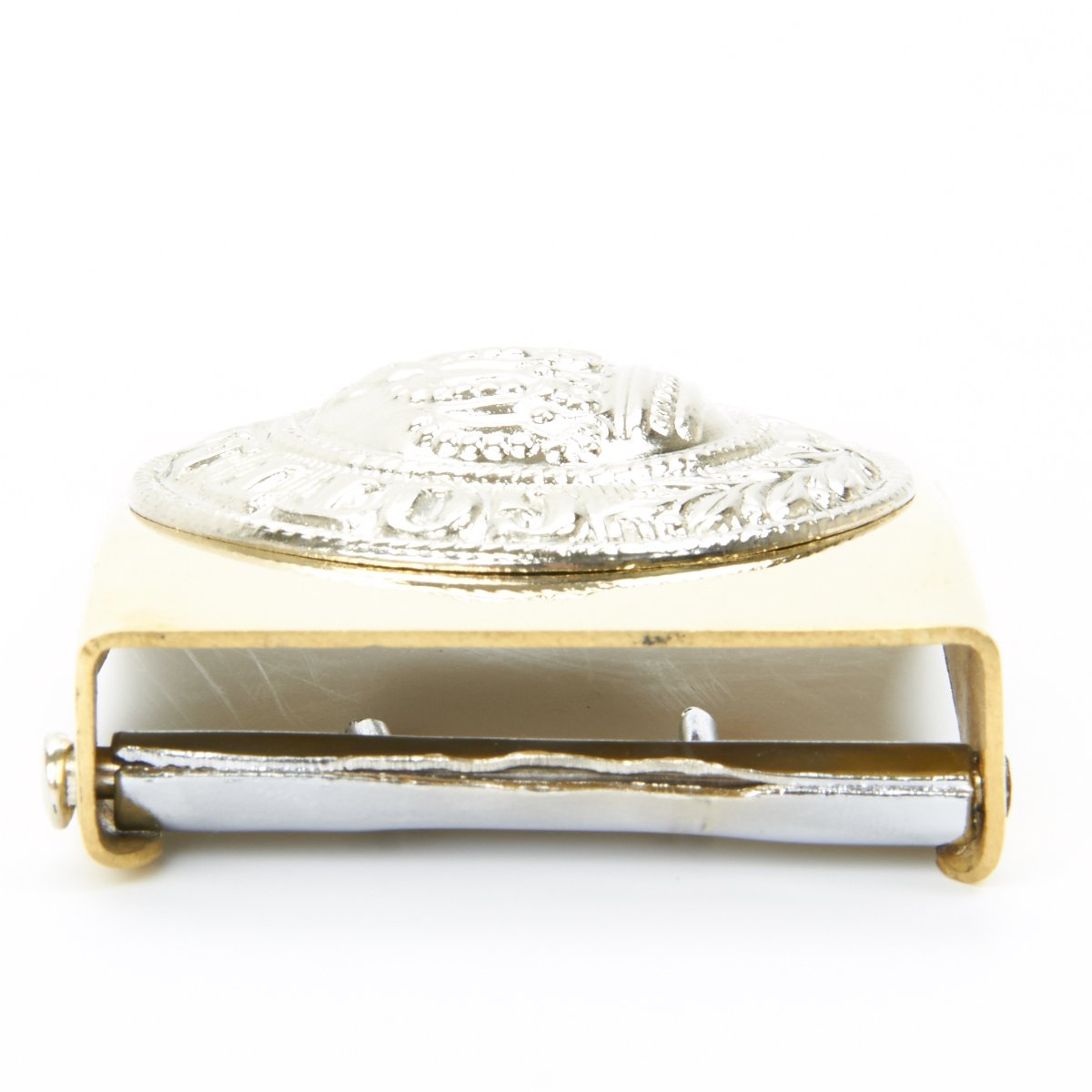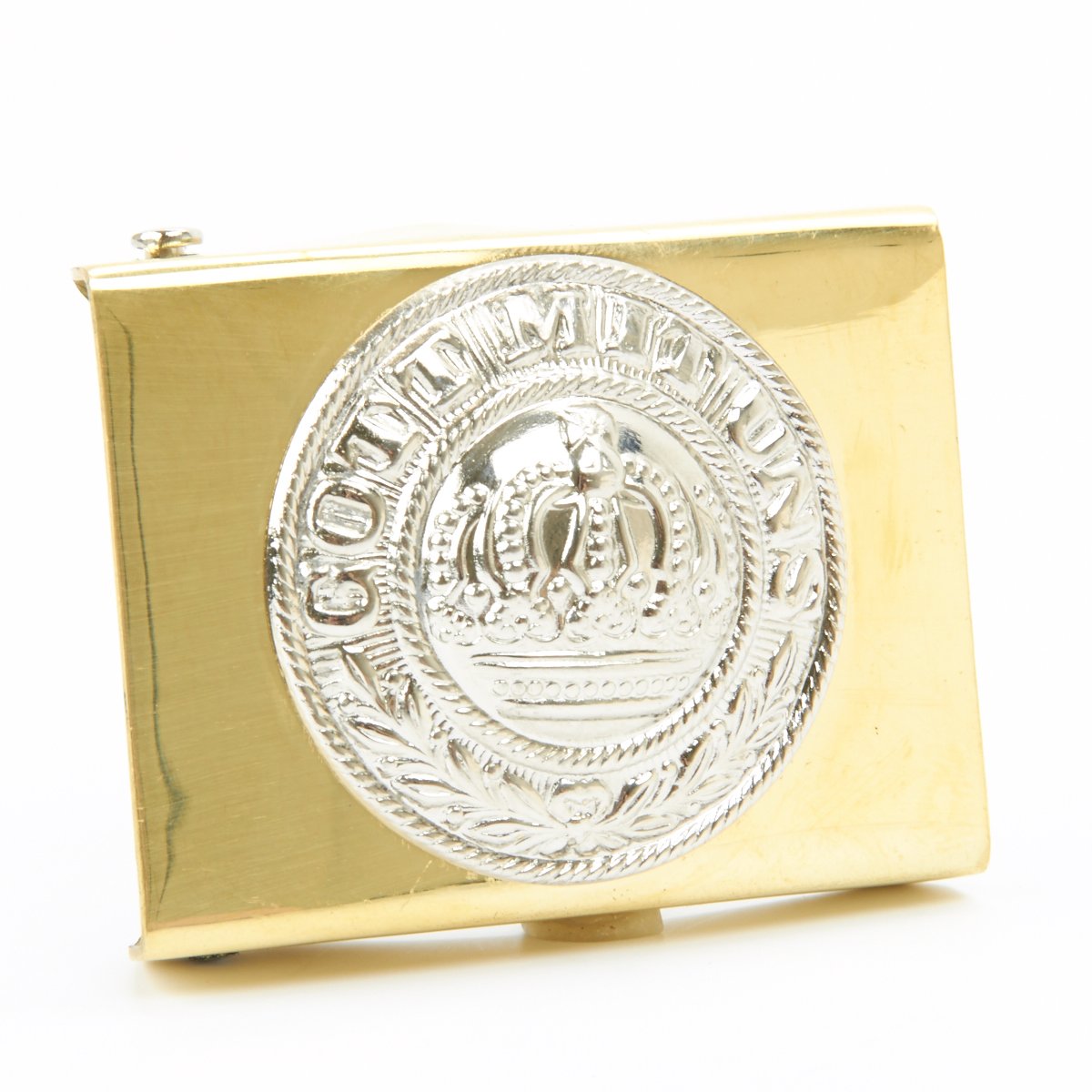German WWI Brown Leather Belt with Prussian Brass and Nickel Gott Mit Uns Buckle New Made Items
$ 39,95 $ 23,97
New Made Item: Standard issue brown leather belt for the German Great War Soldier. Worn with both garrison and combat equipment. These fine quality reproductions are copied directly from originals in the IMA collection.
The belt is constructed of genuine top-grain brown leather finished on both sides and complete with authentic heavy linen stitching. Prussian WWI belt buckle has been struck from dies created through copying originals in the IMA collection. These buckles are well crafted and authentic down to small details. Constructed of real Brass buckle with nickel ?Gott Mit Uns? (God is with us) crest. Known as a field buckle or Koppelschloss
Specifications-
Width: 1.75 Inches (4.5cm)
Thickness: 3-4mm
Designed to be worn over the tunic and sits high up on the waist (not down by the hips) please order at least 2-4 inches more than your actual waist size. Belts are adjustable approximately 2.5 inches in either direction.
History of German World War I Belt buckles-
German belt buckles remained largely unchanged for over a hundred years spanning the 19th and 20th centuries. Although there were modest changes, the basic manufacture did not change until the Great War. War time would have seen three primary variations of buckles. The first was the standard 1895 model. This model is easily distinguished by its brass body and soldered nickel/silver roundel, which would bear the insignia and motto of the German state for whom it was made. Those states using a roundel were as follows:
Prussia – Gott Mit Uns (God is With Uns)
Bavaria – In Treue Fest (In True Faith)
Wurttemberg – Furcthlos und Treu (Fearless and Loyal)
Saxony – Providentiae Memor (Providence in Mind)
Other smaller states had their own unique buckles that did not use a roundel, such as Hessia. The 1895 buckles saw action primarily at the beginning of the war (although some certainly would have been used throughout). It was decided in 1915 to change the manufacture. The reason was two fold, to do away with the bright brass on the battlefield, and to ration precious resources. In 1915, steel buckles were introduced. During 1915, the bodies were made out of steel, but soldered roundels were still applied. In 1916, it was decided to simply stamp the entire buckle out of one piece of steel and do away with the roundels altogether. The steel buckles were typically painted with grey field paint to prevent any shine. Belt buckles were occasionally makers marked and dated. It is also possible to find them with regimental markings. For the most part, dated and marked examples are brass models and are most commonly seen on Saxon buckles.
| Size | 32-36 (81-91cm), 36-40 (91-101cm), 40-44 (101-112cm), 44-48 (112-122cm) |
|---|
Prompt Shipping and Professional Packaging
We provide a variety of shipping options due to our long-running partnerships with UPS, FedEx and DHL. Our warehouse personnel are well trained and will pack the goods according to our exact and precise specifications. Before shipping your items will be thoroughly inspected and secured. Every day, we deliver to thousands of customers in different countries. This is a sign of our determination to become the largest online retailer worldwide. Both Europe as well as the USA have warehouses and distribution centers.
Note that orders containing more than one item will be subject to a processing period that is based to the particular item.
Prior to shipping the items, our staff will carry out an exhaustive inspection of the products you ordered. Today, most orders will be delivered within 48 hours. The estimated delivery time is between 3-7 days.
Returns
The stock is constantly changing. It's not entirely managed by us since we are involved with multiple entities, including the factory and our storage. Therefore, the actual inventory could alter at any time. It is possible that you will not receive your order after the order has been made.
The period of time is 30 days. Unfortunately, if 30 days have passed since you purchased your product, we are unable to provide a refund or exchange.
The item must not be in use and must be in the original packaging. The item must be in the original packaging.
Related products
Uncategorized
Uncategorized
Uncategorized
Uncategorized
Uncategorized
Uncategorized
Uncategorized
Armoured Fighting Vehicles of the World: AFVs of World War One (Hardcover Book) New Made Items
Uncategorized
Uncategorized
Uncategorized
Uncategorized
Uncategorized
Uncategorized
Uncategorized
Armored Burgonet Helmet & Polearm from Scottish Castle Leith Hall Circa 1700 Original Items
Uncategorized
Australian WWII Owen MK1 Machine Carbine SMG Custom Fabricated Replica with Sling Original Items
Uncategorized
Uncategorized
Uncategorized












































































